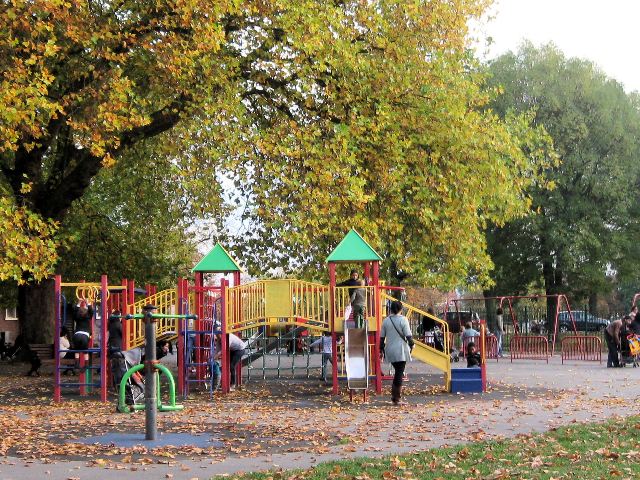Down Syndrome
Children with Down syndrome usually need support all their lives. As you may have seen in the Birth to 6 part of this course, Down syndrome is a chromosomal disorder that usually affects every aspect of a child’s development.
Children with Down syndrome generally have delays in all areas of development. Some of these delays get more pronounced, or visible, when the children get older. Below is a brief description of how Down syndrome affects different developmental areas in children who are between the ages of 6 and 12 years (Fig. 1):
Figure 1. Down Syndrome
- The development of cognitive skills: children with Down syndrome have cognitive skills that are behind those of their typically developing peers. They tend to be slower to process information. They do not seem to use their working memory as efficiently as others do. It is also believed that children with Down syndrome struggle when it comes to generalizing what they learn from one situation to another, and have trouble linking new information to information stored in their long term memory.
- Children with Down syndrome are very concrete thinkers. They need to see, hear, feel and touch something before they can learn it. In other words, children with Down syndrome learn best when they are given information in a multi-sensory fashion (Fig. 2). Children with Down syndrome may be able to solve simple, single-step problems on their own, but they often need help with a multi-step or completely new problem.
Figure 2. Five senses
- The development of academic skills: children with Down syndrome will usually need help in all academic areas. Many of them struggle with the basics of reading, writing and math. They will need specialized and highly individualized help in order to learn how to read, write and learn math.
- When it comes to reading, children with Down syndrome will need to be taught how to read in very concrete and multi-sensory ways. They will need repeated instruction and it will usually take them much longer to learn the basics of reading.
- Children with Down syndrome will also need a lot of help in order to learn how to write. Since they continue to struggle with poor fine motor skills (please see motor development section below), their writing and spelling skills may not be very good. They will learn how to write and spell, but they will do so at a slower rate.
- Math is another area in which many children with Down syndrome will struggle. Math instruction will need to be intensive and highly concrete. When they get a little older, children with Down syndrome will need to be taught how to use math in real-life situations, such as buying what they need from a store.
- The development of communication skills: children with Down syndrome will usually continue to have difficulty in the communication domain. Most of them are able to get their point across to others quite well, but they appear to do so in very simple and concrete ways. Most of the time, they use very simple sentences and they often struggle with articulation. This could be because of muscle weakness in the oral/motor area of development (please see motor section below).
- Children with Down syndrome can usually follow simple commands, but may need help understanding and following complex and multi-step directions (for example, “First go to your room, then get the book, then give it to Dad”). Although quite social, many children with Down syndrome struggle with the pragmatic side of language. That is, many of them may not understand personal space (as it relates to their culture), or the fact that they sometimes have to wait for their turn to communicate to someone.
- The development of motor skills: children with Down syndrome walk, run, go up and down stairs and can usually use all playground equipment (Fig. 3) (for example: slides, monkey bars and swings). They may be slower than their peers, but they can usually participate in most motor-based and physical education activities. The fine motor skills of children with Down syndrome may present them with problems, especially when it comes to writing or typing on a keyboard. They may not have enough dexterity (that is, good fine motor control of the muscles of their fingers to write or draw as fast as their peers, but they are able to do so.
- The oral/motor area in children with Down syndrome may also continue to be a bit delayed compared to their typically developing peers. This can be seen in children who continue to struggle with articulation and chewing. Some may continue to drool, because they do not have a lot of control of their oral/motor muscles. However, most children with Down syndrome can write, draw and eat independently.
Figure 3. Playground
- The development of social and emotional skills: many children with Down syndrome are a joy to their parents and anybody who knows them. However, they may appear to be stubborn sometimes. This could be the result of their inability to get their point across. Although quite friendly, children with Down syndrome will need help with their social skills. They may not know how to approach others in socially acceptable ways and may appear socially immature. Their emotional skills may also be delayed because many of them struggle with identifying their emotions and those of others.
- The development of adaptive skills: children with Down syndrome are usually able to get dressed and undressed independently. Some may struggle with small buttons and tying shoe laces because of fine motor difficulties. Some may need to be reminded to wash their hands after a meal, or to brush their teeth before they go to bed. They may forget to scrub every part of their body when taking a shower or a bath and may need reminders. They may also need to be reminded to brush their hair before they leave the house. But most children with Down syndrome are usually able to get a simple snack on their own (for example, make a peanut-butter and jam sandwich), and they often help their parents with household chores (Fig. 4). Young early-maturing girls with Down syndrome may need to be taught what to do and how to care for themselves in terms of hygiene when they start to menstruate.
Figure 4. Chores
Most children with Down syndrome attend regular schools and many of them are fully integrated into a regular classroom. They all have Individualized Education Plans (or IEPs) and some have a school support worker or educational assistant (or EA) who helps them in the classroom. Most children with Down syndrome will be on a modified IEP as opposed to an adapted one. This means that they will have to achieve different and simpler learning outcomes (adapted IEP) than their typically developing peers.
Most children with Down syndrome who are between the ages of 6 and 12 will benefit from the following services:
- Special education assistance: children with Down syndrome will need the help of a special educator at their school. This special educator will serve on their IEP team, offer suggestions to their teacher, and may come into the classroom to help integrate them into it.
- Speech therapy: most children with Down syndrome will continue to need speech therapy services to keep working on all aspects of their communication skills.
- Occupational therapy: some children with Down syndrome may need continued help from an occupational therapist who will help them improve and develop their fine motor and oral/motor skills.
- Physiotherapy: some children with Down syndrome may need continued help from a physical therapist to improve their gross motor skills.
- Some children with Down syndrome will get diagnosed with hearing loss at some point in their lives. If that happens, they will need the help of an audiologist.
- Some children with Down syndrome will get diagnosed with vision loss, or conditions like nistagmus (see full Glossary) and strabism (see full Glossary) at some point in their lives. If that happens, they will need the help of an ophthalmologist.
- Please click here for more information on vision impairments and conditions or hearing loss for children with Down Syndrome.
Some children with Down syndrome may also get diagnosed with a number of medical conditions. They appear to be more susceptible to these conditions than the general population. Some of these medical conditions include:
- Eczema (see full Glossary) and other skin conditions;
- Heart and cardiac problems;
- Thyroid problems;
- Orthopedic problems;
- Certain types of cancer, including Leukemia;
- Autism
Should this happen, children with Down syndrome will need help from highly specialized professionals in the medical field.
Finally, children with Down syndrome can and should be included in all aspects of typical life. They may need a little bit of help, but they are quite capable of engaging in most of the same activities as their peers.




0 comments
Kick things off by filling out the form below.
Leave a Comment